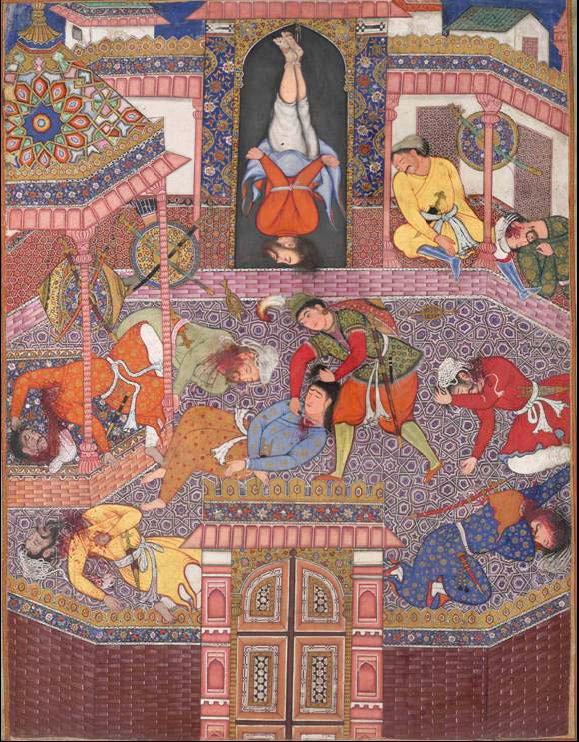
Shop Amazon - Create an Amazon Baby Registry
Mahiya slays Gharrad's companions
From the Hamza Nama painted in 1570 for Akbar.

Source


Hamzanama paintings sometimes depict passages tangential to what seems to be the primary narrative direction of the associated text. Four consecutive text pages advance the story of Prince Ibrahim’s and Ghazanfar’s rival quests for Khwarmah, whom they both love. A painting facing the second of these text pages depicts an event involving Mahiya and Zambur, spies for Prince Ibrahim:As for Mahiya, she saw that it was late and she was waiting for Zambur to return. When a long time had passed she got upset. She put on her veil and boots and went outside the house, looking all through the marketplace until she came to that place. There she saw that someone [Zambur] was suspended upside down and a group of men had been drinking wine. The utensils of the party were scattered, and the participants were lying all over the place. She went forward and, recognizing Zambur, set him free. Then she drew a knife from her belt and cut off the heads of all Gharrad’s companions. She hung Gharrad up in Zambur’s place and went back home with Zambur.1The painting shows Mahiya cutting off a sleeping man’s head, six other dead men with their necks cut, Zambur hanging upside down in a doorway, and Gharrad still sleeping nearby.2 While the painting impressively portrays a forceful Muslim woman, it and the associated story have little to do with the rival quests for a beloved.
1 Id., trans. for cat. 61, p. 303. Current popular and scholarly discussions probably would focus on the detail that Mahiya put on her veil. For a more interesting exploration of women in the medieval Islamic world, see Hambly (1998). Many more men than women are killed in the Hamzanama text. This also tends to be a feature of the contemporary world (currently in the U.S. about three times as many men are victims of homicide as are women). Those who dare to note male deaths tend to note quickly and apologetically that most killers are male. E.g. Corballis (2002) p. 136, n. 33. But the sex of killers is not significantly related to the experience of death.
2 Seyller (2002) cat. 61.